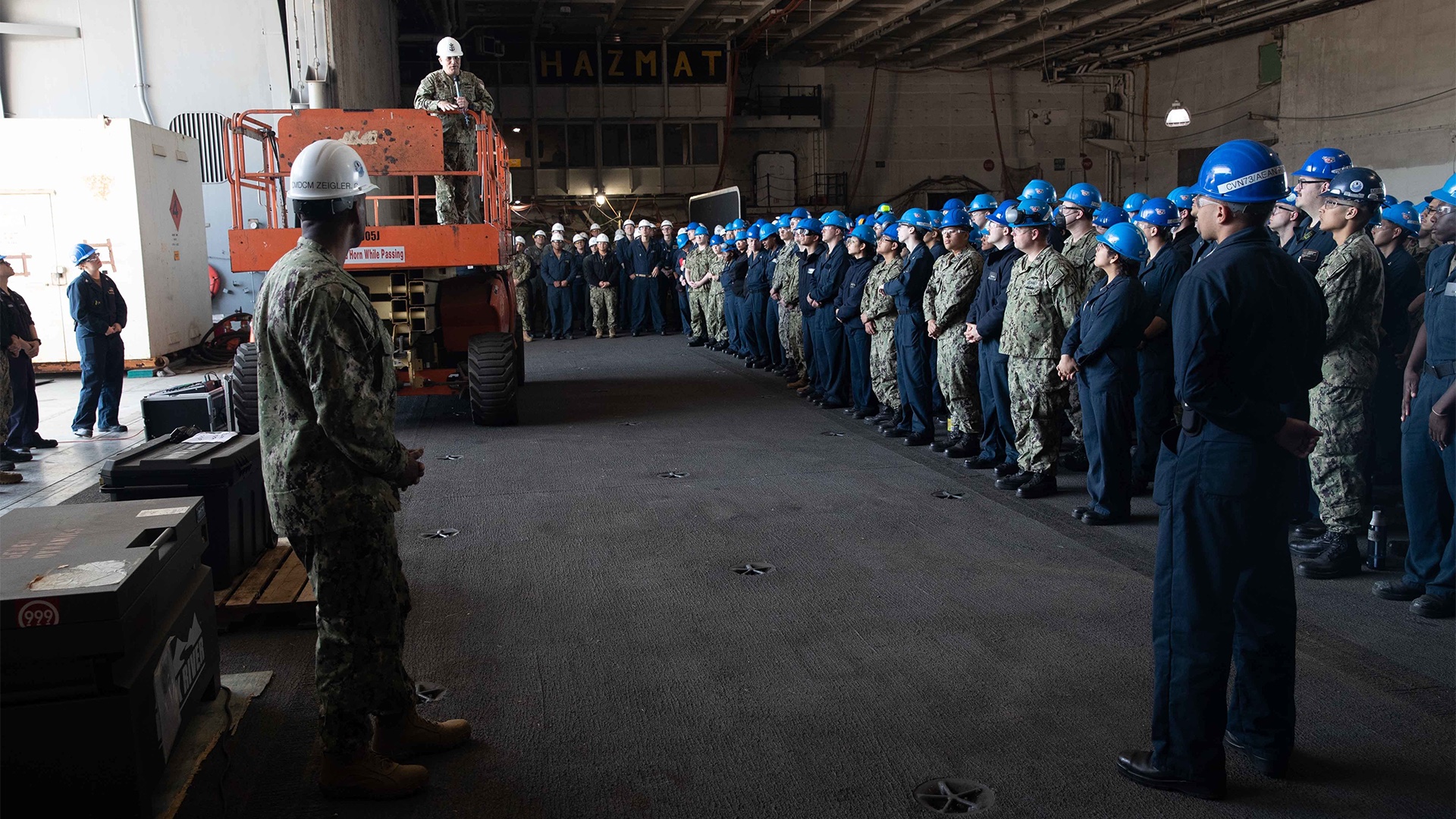

Over the course of one week in April 2022, three sailors assigned to the aircraft carrier USS George Washington took their own lives. On Thursday, the Navy released the findings of an extensive investigation into the conditions sailors from the USS George Washington faced during its years-long refurbishment process at a Newport News, Virginia shipyard, along with 48 separate recommendations for improving sailor quality of life and quality of work.
“Collectively, Navy senior leadership, officer and civilian, let our standards slip – and in doing so we let our people down,” wrote Chief of Naval Operations Adm. Michael Gilday and Navy Secretary Carlos Del Toro in a service-wide memo that accompanied the findings and recommendations.
The investigation revealed the poor living conditions for junior sailors both on and off the ship, an understaffed crew lacking in senior leadership, chaotic work schedules that often inconvenienced sailors, and mental health resources lacking.
The USS George Washington entered the Huntington Ingalls Industries-Newport News Shipyard in 2017 for a planned four-year-long refurbishment process that “presents tremendous challenges to crew quality of life due to both the shipyard environment and the long duration Sailors must live and work in that environment,” as the report notes.
Subscribe to Task & Purpose Today. Get the latest military news, entertainment, and gear in your inbox daily.
The report identified there are no minimum manning requirements for aircraft carriers undergoing refurbishment, and as a result, the USS George Washington was consistently undermanned, especially among more senior ratings. This left the crew spread thin, with junior sailors receiving little oversight or mentorship. One chief petty officer assigned to the ship in February 2021, for instance, told the investigation team she was the first supervisor in her section in over a year. Elsewhere, the ship had a single personnel clerk processing thousands of pay transactions, leaving sailors underpaid or sometimes not paid on time at all.
The report also found the ship’s command resilience team (CRT) often lacking and not performing its required tasks. The CRT meetings were often poorly attended, with members not being notified of their position in writing and records of the meetings rarely maintained. The ship’s executive officer, who was supposed to head the CRT, was not aware of this requirement and did not attend a meeting during his first four months aboard.
“USS George Washington CRT functioned poorly and did not execute its duties and responsibilities effectively,” the report said.
Participation in command climate surveys was also low, with two 2021 surveys having response rates of just 12% and 11%.
The results of the surveys, though, were troubling. In 2019, the ship’s command climate survey results were below both aircraft carrier and Navy-wide averages in all categories, showing little improvement in 2020. In that same 2019-2020 timeframe, service member awareness of suicidal ideations increased from 36% to 56%.
The report further identified that the Navy had no set standard for determining when a ship was habitable by sailors while undergoing refurbishment.
In June 2021, with the refurbishment process already behind schedule and another aircraft carrier scheduled to arrive at the shipyard, sailors began moving aboard the USS George Washington. This exposed them to harsh, noisy conditions in what was, essentially, still a construction zone. The report concluded the “USS George Washington crew move aboard was premature.”
When not on the ship, unaccompanied junior sailors were housed in Huntington Hall, a housing facility maintained by the shipyard. There, they stayed in shared rooms that allowed for roughly 85 square feet per sailor. A 2010 study had already found the building contained asbestos and lead paint.
The report also revealed the ship’s mental health resources were stretched thin during its time in the shipyard, with the USS George Washington’s psychologist encountering a “significantly higher number of patients per month than the Defense Health Agency (DHA) standard, indicating demand beyond what is acceptable for a single provider.”
The report also detailed sailors feeling discouraged or afraid to seek out mental health resources.
“I have developed mental issues that I feel I cannot resolve because I KNOW [original emphasis] my chain of command does not care and production is what must be pushed every day to the maximum. I feel unsafe asking my leadership for help or even telling them I am going to see the psych boss, or chaplain or whatever because in return they will make me stay late to complete the work I was unable to do when I was at said appointment,” responded one sailor in a July 2021 command climate survey.
As a result of the findings, the report issued 48 recommendations. These include limiting the number of first-term sailors assigned to ships undergoing maintenance, improving off-ship housing conditions, and no longer having sailors stay on ships or barges when not underway. They also include expanding mental health staff manning for ships, and general quality of life improvements such as expanded Wi-Fi access, food, and parking options at Naval facilities.
“We are working daily and aggressively to ensure support and resources are available to Sailors in the shipyards, at sea, and at home,” said Adm. Daryl Caudle, commander of U.S. Fleet Forces Command, in a Navy statement.
The full report can be found here.
The latest on Task & Purpose
- Special Forces soldiers reveal first details of battle with Russian mercenaries in Syria
- Who was General Mark Milley before he was ‘The Chairman’?
- What we know about the Marine veteran who killed Jordan Neely on the New York City subway
- Fort Benning, ‘home of the Infantry,’ is now Fort Moore
- Ukraine claims it has routed a Russian brigade near Bakhmut
